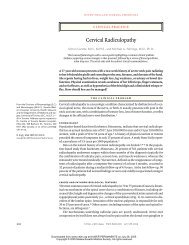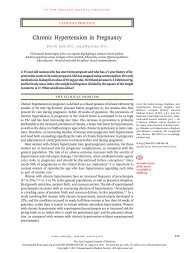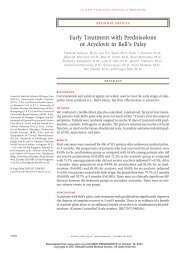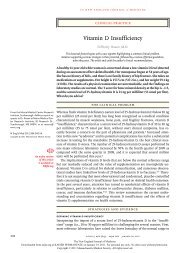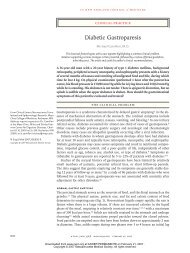Hypoparathyroidism - Q-Notes for Adult Medicine
Hypoparathyroidism - Q-Notes for Adult Medicine
Hypoparathyroidism - Q-Notes for Adult Medicine
You also want an ePaper? Increase the reach of your titles
YUMPU automatically turns print PDFs into web optimized ePapers that Google loves.
The new england journal of medicine<br />
Parathyroid<br />
cell<br />
Bone<br />
resorption<br />
Bone<br />
CaSR<br />
Low<br />
Ca 2+<br />
PTH<br />
+<br />
+<br />
Increased<br />
calcium<br />
reabsorption,<br />
decreased PO 4<br />
3−<br />
reabsorption<br />
PTH<br />
Low serum Ca 2+<br />
sensed through<br />
CaSRs<br />
25(OH)D<br />
1,25(OH) 2 D<br />
Kidney<br />
Parathyroid<br />
glands<br />
Intestine<br />
Increased Ca 2+<br />
and PO 4<br />
3−<br />
Increased Ca 2+<br />
and PO 4<br />
3− into serum<br />
(normal range restored)<br />
Figure 1. Control of Mineral Metabolism by Parathyroid Hormone.<br />
Levels of serum ionized calcium (Ca 2+ ) are tightly controlled through<br />
the action of parathyroid hormone (PTH) and 1,25-dihydroxyvitamin D<br />
(1,25[OH] 2 D). Both the rate and magnitude of changes in the serum ionized<br />
Ca 2+ concentration are detected by extracellular calcium-sensing receptors<br />
(CaSRs) expressed on parathyroid cells. When ionized Ca 2+ levels<br />
COLOR FIGURE<br />
decrease, the release of PTH secretion is triggered. Conversely, when ionized<br />
Ca 2+ levels increase, PTH secretion is suppressed. PTH stimulates<br />
Version 5 07/3/08<br />
Author Shoback<br />
bone resorption, which delivers calcium and phosphorus (PO 3− Fig # 1<br />
4 ) into the<br />
circulation. In the kidney, PTH Title stimulates <strong>Hypoparathyroidism</strong> renal reabsorption of calcium<br />
and promotes phosphate ME excretion. PTH also enhances the conversion<br />
DE Solomon<br />
of 25-hydroxyvitamin D (25[OH]D) to the active vitamin D metabolite<br />
Artist TV<br />
1,25(OH) 2 D, which increases the<br />
AUTHOR<br />
transepithelial<br />
PLEASE NOTE:<br />
transport of calcium and<br />
Figure has been redrawn and type has been reset<br />
PO 3− 4 through actions in intestinal cells. In concert, these steps restore<br />
Please check carefully<br />
ionized Ca 2+ levels to the normal<br />
Issue date<br />
range,<br />
07/24/08and, through the actions of PTH<br />
and other factors (e.g., fibroblast-derived growth factor 23) in the kidney,<br />
reset the level of serum PO 3− 4 within the normal range. When the actions<br />
of PTH are reduced or lost, all subsequent steps in the maintenance of<br />
homeostasis are impaired, resulting in hypocalcemia, hyperphosphatemia,<br />
and hypercalciuria.<br />
+<br />
Acquired hypoparathyroidism is most commonly<br />
the result of inadvertent removal or irreversible<br />
damage to the glands, usually to their<br />
blood supply, during thyroidectomy, parathyroidectomy,<br />
or radical neck dissection. Definitions<br />
of permanent postsurgical hypoparathyroidism<br />
vary, but the definition is generally accepted to<br />
be insufficient PTH to maintain normocalcemia<br />
+<br />
6 months after surgery. <strong>Hypoparathyroidism</strong> is<br />
estimated to occur after approximately 0.5 to 6.6%<br />
of total thyroidectomies; the rates of this complication<br />
are even higher in some case series,<br />
whereas reported rates at endocrine surgical centers<br />
with high volumes are 0.9 to 1.6%. 25-28 The<br />
occurrence of hypoparathyroidism depends on<br />
the surgeon’s experience, extent of thyroid resection<br />
and nodal dissection <strong>for</strong> cancer, and underlying<br />
thyroid disease, with the presence of substernal<br />
goiter, cancer, or Graves’ disease increasing<br />
the risk. The risk is also greater if one or more<br />
parathyroid glands are not identified intraoperatively<br />
and if the procedure is a reoperation.<br />
Parathyroid secretory reserve is ample, so considerable<br />
damage must occur be<strong>for</strong>e hypoparathyroidism<br />
develops. It is estimated that one normal<br />
gland is sufficient <strong>for</strong> maintaining PTH levels and<br />
serum calcium homeostasis. Immune-mediated<br />
destruction of the parathyroid glands can be either<br />
isolated or part of autoimmune polyendocrine<br />
syndrome type 1 (APS-1). <strong>Hypoparathyroidism</strong><br />
may also be caused by accumulation in the<br />
parathyroid glands of iron (hemochromatosis or<br />
transfusion-dependent thalas semia) 5-7 or copper<br />
(Wilson’s disease) 8 or (in rare cases) by iodine-<br />
131 therapy <strong>for</strong> thyroid diseases 29 or metastatic<br />
infiltration of the parathyroid glands by tumor 30<br />
(Tables 1 and 2).<br />
Magnesium depletion or excess may cause<br />
hypocalcemia by inducing functional hypoparathyroidism.<br />
9,44-46 Magnesium is essential <strong>for</strong> PTH<br />
secretion and activation of the PTH receptor by<br />
ligand. In hypomagnesemia, PTH levels are inappropriately<br />
low or in the lower portion of the<br />
normal range, in the presence of usually mild<br />
hypocalcemia, because the parathyroid is unable<br />
to secrete sufficient hormone, and renal and skeletal<br />
responses to PTH are blunted. In rare instances,<br />
when magnesium is administered parenterally<br />
(e.g., in tocolytic therapy) or accumulates<br />
because of renal insufficiency and serum magnesium<br />
levels rise, PTH secretion is inhibited. 44,45<br />
Magnesium, like calcium, can activate extracellular<br />
calcium-sensing receptors and suppress<br />
PTH release. 47 Once the magnesium status is corrected,<br />
the capacity to secrete PTH and respond<br />
to it resumes.<br />
Genetic disorders must also be considered as<br />
a possible cause of hypocalcemia. The DiGeorge,<br />
or velocardiofacial, syndrome, due to microdele-<br />
392<br />
n engl j med 359;4 www.nejm.org july 24, 2008<br />
Downloaded from www.nejm.org at KAISER PERMANENTE on July 23, 2008 .<br />
Copyright © 2008 Massachusetts Medical Society. All rights reserved.






